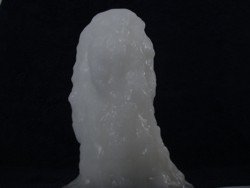Hot Ice
Sodium Acetate
Hot Ice is the name given to a super saturated solution of sodium acetate and water. To super saturate basically means that more molecules are packed between the water molecules than would normally occur at room temperature. This super saturated solution can be prepared by heating the water up which excites the water molecules and lets more salt, sugar or sodium acetate in this case dissolve between them. Sodium acetate is actually a salt.
Our Top Gift Ideas for Young Scientists
 |
  |
 |
|---|
Sodium acetate trihydrate is found in some hand warmers. Sodium acetate trihydrate is the same as sodium acetate only it is a hydrated version of it (has water in it). It freezes at 54C⁰ so it is
usually solid at room temperature as long as it is not super cooled. At 15⁰C sodium acetate trihydrate has the perfect temperature to go from liquid to solid in seconds producing heat as it does this (45⁰C). An exothermic reaction is a reaction that produces heat. For example fire is an exothermic reaction. In hot ice the heat is released when the solution starts to freeze because in the process more heat energy converted than is need.
A substance becomes super cooled when it is cooled passed its freezing point but still remains a liquid or gas. This sometimes happens when pure water is cooled passed 0⁰C it stays liquid, but then when it is agitated it turns into solid ice right before your eyes in a matter of seconds. When super saturated solution sodium acetate is cooled passed its freezing point it will stay liquid as long as it is not disturbed. The solution can be disturbed by shaking, but the most reliable method is give the sodium acetate solution a place to form its crystals also referred to as a nucleation point. This could be done by just dropping in a piece of solid sodium acetate or something that
closely resembles the crystalline structure of sodium acetate.
Hot ice will not become super cooled if it is cooled in the presence of a nucleation site so it will freeze just like normal. Like nearly everything super cooling has an opposite, superheating this happens when a substance is heated to or above its boiling point, but does not boil. Super heating sometimes occurs when pure water is heated in the microwave.
How to make Hot Ice
The main ingredient is basically sodium acetate, but that isn’t really something that’s easy to find at just any store. Unless you look for hand warms which usually contain sodium acetate trihydrate. I bought my sodium acetate anhydrous here on Amazon for about $14 USD.
The difference between sodium acetate trihydrate and sodium acetate anhydrous is the former has no water molecules. The steps below describe how I turned sodium acetate anhydrous into sodium acetate trihydrate.
.
First put a tiny bit of water into a pot because you only need 1ml of water for about 5.3 grams. Sodium acetate is not toxic so you can just use a normal pot to heat it in. Just make sure you wash it well after you used it. Sodium acetate is actually used as a food additive in some salt and vinegar chips.
Heat up the water and slowly add the sodium acetate. Once you have dissolved all of the sodium acetate take it off the heat and pour it in to a heat proof container (something that won’t melt when you pour in the hot liquid) and close the container as quickly as possible. If the container is not covered the top layer of the liquid will crystallize and this will cause the liquid to freeze before it becomes super cooled.
The container also needs to be clean and have smooth edges so there is nowhere for the crystals to form. Once it is cool to the touch it will be ready to use. All you have to do is to initiate the solidification of the liquid by adding one of the left over crystals. When you want to reuse the solid crystals just heat it up until all of it has melted and then cool it down again. You can keep reusing it as long as you don’t contaminate it and add a little water now and again to compensate for the lost water due to evaporation during the heating process.
'Science Kids'
Stay updated and subscribe to "Science News For Kids" our monthly e-zine.
Now what to do with the end product, well it helps to use your imagination, but you could make sculptures or use it for magic tricks impressing family and friends. To make a sculpture put a solid crystal on a plate and then pour the hot ice on the crystal and watch the stream of liquid solidify on contact. This experiment also makes a good magic trick because the liquid looks like water, but when it’s brought into contact with a solid sodium acetate crystal it freezes. This can look quite impressive.
Share your experiment related to this topic.
Do you have a great experiment or experience related to this page that you would like to share? Share it!
Go back from "Hot Ice" experiments to home.
